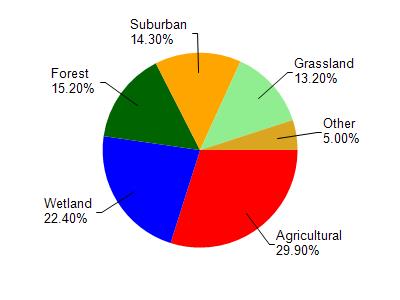Washington
No
No
No
Fish and Aquatic Life
Overview
Rock River Water Quality Management Plan, Lower Rock River Appendix. WT-668-2002. South Central Region, WDNR.
Bark Lake is a fairly good-sized seepage lake in Washington County with 64 surface acres and a mean depth of 14 feet. A lake district has existed for some time but has been inactive. The lake is considered eutrophic and it exhibits sedimentation, septic problems, and severe development pressure. The lake was monitored in 1994. There is currently a moratorium on the development of new septic systems due to groundwater contamination and shallow soils; only holding tanks are allowed. Due to the many needs of this resource, the lake district should either become more involved in the lake or disband.
Date 2002
Author Aquatic Biologist
Historical Description
Source: 1963, Surface Water Resources of Washington County Bark Lake - T9N, R19E, Sec. 26,
A small spring and drainage-fed lake on marsh deposits, generally considered as the headwaters of the Bark River. Managed for largemouth bass and panfish, with northern pike making a minor contribution to the creel. Access is afforded by undeveloped public right-of-way along the west shore, and by fire lanes. Over 80 per cent of the community residents live here year-round. Weeds and stunted panfish are major use problems. Water skiing and speedboating are regulated by Town of Richfield ordinance. About 55 acres of tamarack and shrub swamp adjoin the east end of the lake and offer some nesting of mallards and black ducks. Hunting is permitted but of marginal quality.
Surface Acres = 65, S.D.F. 1.59, Maximum Depth = 32 feet.
Date 1963
Author Surface Water Inventory Of Wisconsin
Condition
Wisconsin has over 84,000 miles of streams, 15,000 lakes and milllions of acres of wetlands. Assessing the condition of this vast amount of water is challenging. The state's water monitoring program uses a media-based, cross-program approach to analyze water condition. An updated monitoring strategy (2015-2020) is now available. Compliance with Clean Water Act fishable, swimmable standards are located in the Executive Summary of Water Condition in 2018. See also the 'monitoring and projects' tab.
Reports
Recommendations
Aquatic Plant Monitoring or Survey
Water Quality Modeling
Aquatic Plant Management Plan
Informational Meetings
Lake Classification
Phase 3 of Lake Classification Project. Public Hearing and Ordinance revision adoption for the lakes in Washington County. Dissemination of proposed ordinance changes to the other local units of government. Enforcement of revised zoning provisions related to shorelands, wetlands, and floodlands through current channels. Information to public of changes in Washington County codes by meetings, publicity, pamphlets, and brochures.
Lake Classification
Through this project Washington County will develop a waterbody classification system; review and revise shoreland-wetland and floodplain ordinances; and refine the ordinance provisions governing shorelands, wetlands and floodlands, incorporating the waterbody classification into them.
Management Goals
Wisconsin's Water Quality Standards provide qualitative and quantitative goals for waters that are protective of Fishable, Swimmable conditions [Learn more]. Waters that do not meet water quality standards are considered impaired and restoration actions are planned and carried out until the water is once again fishable and swimmable
Management goals can include creation or implementation of a Total Maximum Daily Load analysis, a Nine Key Element Plan, or other restoration work, education and outreach and more. If specific recommendations exist for this water, they will be displayed below online.
Monitoring
Monitoring the condition of a river, stream, or lake includes gathering physical, chemical, biological, and habitat data. Comprehensive studies often gather all these parameters in great detail, while lighter assessment events will involve sampling physical, chemical and biological data such as macroinvertebrates. Aquatic macroinvertebrates and fish communities integrate watershed or catchment condition, providing great insight into overall ecosystem health. Chemical and habitat parameters tell researchers more about human induced problems including contaminated runoff, point source dischargers, or habitat issues that foster or limit the potential of aquatic communities to thrive in a given area. Wisconsin's Water Monitoring Strategy was recenty updated.
Grants and Management Projects
Monitoring Projects
| WBIC | Official Waterbody Name | Station ID | Station Name | Earliest Fieldwork Date | Latest Fieldwork Date | View Station | View Data |
|---|
| 828600 | Bark Lake | 10044574 | Bark Lake - Access | 6/13/2016 | 8/22/2025 | Map | Data |
| 828600 | Bark Lake | 673119 | Bark Lake - Deep Hole | 9/6/1979 | 12/1/2025 | Map | Data |
| 828600 | Bark Lake | 10007159 | Bark Lake | 6/1/1995 | 7/15/2024 | Map | Data |
| 828600 | Bark Lake | 674002 | Bark Lake - Bark Lake | | | Map | Data |
|

Watershed Characteristics
Bark Lake is located in the Bark River watershed which is 185.84 mi². Land use in the watershed is primarily agricultural (29.90%), wetland (22.40%) and a mix of forest (15.20%) and other uses (32.50%). This watershed has 265.69 stream miles, 3,499.26 lake acres and 22,145.94 wetland acres.
Nonpoint Source Characteristics
This watershed is ranked Medium for runoff impacts on streams, High for runoff impacts on lakes and High for runoff impacts on groundwater and therefore has an overall rank of High. This value can be used in ranking the watershed or individual waterbodies for grant funding under state and county programs.However, all waters are affected by diffuse pollutant sources regardless of initial water quality. Applications for specific runoff projects under state or county grant programs may be pursued. For more information, go to surface water program grants.